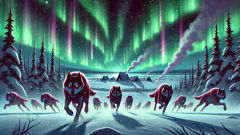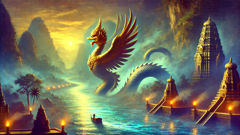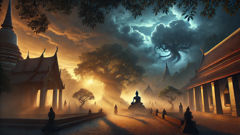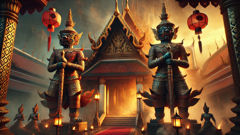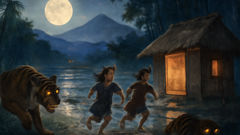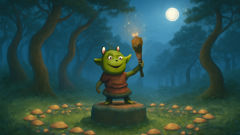Introduction
The vast, icy wilderness of the Canadian Arctic stretches out beneath an endless sky, where the wind sings through snow-laden forests and the stars flicker like silent watchers. In this frozen land, the boundaries between the human and the wild are blurred, and every shadow may hold a secret as old as time itself. The Inuit people have lived here for millennia, their stories rising from the frost and lingering in the air like mist. Among their most enigmatic legends is that of the Adlet—creatures born not wholly human, nor wholly beast, but forged from an ancient union that defied the natural order. The Adlet are said to be the offspring of a daring woman and a red dog, their existence a testament to the unpredictability of love, the danger of crossing forbidden boundaries, and the unbreakable ties that link humanity to the animal world. This is a tale of survival and transformation, of families torn apart by fate and yet bound together by blood, and of the enduring presence of myth in the heart of the Arctic. To walk through the silent pines beneath the flickering northern lights is to enter a world where the Adlet still run, their footprints etched forever in snow and legend.
The Forbidden Union
Long ago, before any hunter’s memory and before the first kayak touched the endless white of the Canadian Arctic, there lived a young woman named Nivi. She was born into a small village on the edge of a vast and restless land, where the ice met the sea and wolves howled at the moon. Nivi’s hair was as black as raven’s wings, her eyes sharp and searching, reflecting the cold clarity of the northern night. She was the daughter of a respected shaman, a man who listened to the land and spoke with the spirits of wind and stone. Yet, for all her father’s wisdom and the strength of her mother’s arms, Nivi felt an emptiness grow inside her—a longing as deep as the dark water beneath the ice.
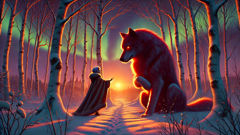
Her people lived by the rules handed down through generations: never hunt more than you need; never leave the child or the elder behind; and never stray into the wildest places, where the spirits walk and ancient things remember. But it was in those wild places that Nivi found solace. She wandered far beyond the safety of her village, drawn by curiosity and a hunger for something nameless. On these solitary journeys, she would listen to the song of the wind, gather smooth stones from the shore, and sometimes see fleeting shapes at the edge of her vision—a flash of red fur, a shadow with amber eyes.
One evening, as twilight melted into the deep blue of polar night, Nivi felt herself being watched. The air was still, so silent she could hear her own heart. Then, out of the birch trees, he appeared—a creature as red as fresh blood on snow. He was a dog, but larger than any she had seen, with a coat that shone like fire and eyes that glowed with strange intelligence. The villagers spoke of such beasts in hushed tones, calling them omens or messengers from the land of spirits. But Nivi was not afraid. Instead, she felt a thrill of recognition, as though she had met an old friend at last.
The dog circled her, keeping his distance, his breath steaming in the cold. Nivi knelt, holding out a hand, murmuring words of peace. To her astonishment, the dog sat before her, his eyes never leaving hers. For many nights, they met in this secret way—Nivi and the red dog, each teaching the other the language of trust. She shared scraps of dried fish and seal fat; he brought her gifts of antler, feathers, and once, a gleaming stone unlike any she had seen. In time, affection grew into something deeper. It was love that defied explanation, as wild and impossible as a river running uphill.
When Nivi’s belly began to swell, the village elders grew uneasy. They saw her walking alone at night, whispering into the wind, returning with strange tokens in her parka. Her mother wept quietly. Her father watched the moon and muttered prayers. Soon it could not be hidden: Nivi was with child, and no man had claimed her. The elders demanded answers, but she remained silent. Only the shaman knew part of the truth, and he feared it. For in the stories of their people, unions with spirits or beasts brought misfortune. The boundary between worlds was not to be crossed.
The birth came on a night when the aurora blazed bright enough to turn night into day. Nivi labored in silence, her mother and the village midwife by her side. What came into the world that night would change their people forever. Five children, strong and strange, emerged from her womb. They were red-haired, with bodies lean and long, their faces an unsettling mix of human features and the snout of a dog. They yelped and whimpered, then opened their eyes—amber and wild, like their father’s.
Fear swept through the village. The elders saw abomination; the hunters saw danger. Only Nivi saw beauty. She named each child for a spirit of the land—Siku (Ice), Amarok (Wolf), Nanuq (Polar Bear), Uvanga (Self), and Tuktu (Caribou). Her love for them was fierce, but it could not shield them from the cruelty of those who could not understand. In secret, she fed and clothed her children, hiding them in caves and hollows when strangers drew near. But whispers travel swiftly on Arctic wind, and soon the day would come when hiding would no longer be possible.
Exile on the Ice
As the weeks passed, suspicion grew into fear. The villagers whispered that Nivi’s children were not truly human, that they were omens of famine or plague. Some said the red dog was a demon sent to punish them for broken taboos. The shaman, torn between love for his daughter and duty to his people, pleaded for compassion. But fear is a powerful force in places where survival is never certain.
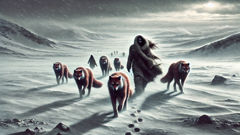
At last, the elders gathered in a council. By the flicker of oil lamps, they argued into the night, weighing mercy against caution. In the end, tradition prevailed: the children could not remain among them. At dawn, Nivi was summoned to the center of the village. Her children huddled close, their fur matted and eyes wide with confusion. The chief spoke the verdict: "These children do not belong to our world. Take them far into the land of snow. You may return alone, but never with them."
Nivi felt her heart shatter. But she did not beg. Instead, she bundled her children into fur-lined hoods, packed what food she could carry, and set off into the cold with her head held high. She would not abandon them. If exile was their fate, she would share it. The wind howled across open tundra, carrying away the last echoes of her village. Behind them, a thin column of smoke marked the only home Nivi had ever known.
For days, they traveled deeper into the wilderness—across frozen lakes, over jagged ridges of blue ice, through forests so silent that their own footsteps seemed to thunder. Nivi taught her children to hunt ptarmigan and fish beneath the ice. She showed them how to build shelter from snow and how to read the sky for signs of coming storms. The Adlet children learned quickly; their senses were keen, their bodies strong and tireless. Yet they were always hungry for affection, for stories of the world they had never known.
Nivi told them about the village by the sea, about laughter around the fire, and about her own childhood beneath a gentler sky. She spoke of their father, who watched over them from the world of spirits. The children listened with wide eyes, clutching one another in sleep. But in their dreams, they ran—swift and silent—across endless white, searching for a place where they belonged.
One night, a great storm descended, burying their camp in snow. Nivi woke to find her children missing. Panic gripped her as she clawed through drifts, calling their names into the darkness. At last she found them: clustered beneath an overhang, safe and warm in each other’s embrace. It was then she realized that her children were not fragile, but born of two worlds—capable of surviving what neither human nor dog alone could endure.
As winter deepened, Nivi grew weak. Her food stores dwindled, and her hands trembled with cold. The Adlet children took over, bringing her fish and rabbit, keeping the fire burning through long polar nights. They became her protectors as much as she was theirs. Yet even as they learned to live in exile, the longing for connection did not fade. They would sometimes catch glimpses of distant camps, hear the faint laughter of other children on the wind. But they dared not approach.
One spring morning, when the snow was soft and the sky pale with new light, Nivi called her children close. She told them her strength was failing, but that they must go on. She spoke of courage and kindness, of honoring both sides of their nature. With tears in her eyes, she blessed each child, pressing her lips to their fur and whispering her love into their ears.
Nivi died beneath a sky streaked with pink and gold. The Adlet children mourned her in silence, burying her beneath a cairn of stones on a hill overlooking the endless snow. From that day on, they wandered farther and wider, carrying her memory and her teachings wherever they went. They became legends—sometimes feared, sometimes pitied, always remembered as beings who walked between two worlds.
The Race of Blood and Snow
As the years passed, the Adlet siblings grew into adulthood, each marked by a unique blend of human wit and canine strength. They roamed the vastness between Greenland and Canada, learning the patterns of caribou migration, the hidden paths beneath glaciers, and the language of ravens. Their survival depended not only on their keen senses but on a fierce loyalty to each other and to the spirit of their lost mother. The legend of their existence spread from camp to camp, whispered around fires as a warning or an explanation for mysterious tracks found in morning snow.
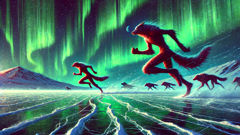
Yet the Adlet were not alone in their wandering. Far to the west, Inuit hunters began to notice that game grew scarce where the red-furred ones passed, and sled dogs returned restless and frightened. Some believed the Adlet stole into camps at night to steal food or children; others thought they were spirits punishing those who had broken sacred rules. Fear hardened into hatred, and soon hunting parties were formed—not for caribou or seal, but to drive out the Adlet from their lands.
The siblings felt the change. One by one, they learned to move only at night, to hide by day in forests or caves. Still, they could not always avoid trouble. One evening, as dusk melted into the violet glow of Arctic twilight, Amarok—the boldest of Nivi’s sons—led his siblings across a frozen river. They heard a distant shout, then saw figures on the horizon: men with spears and bows, faces masked against the wind. The Adlet ran, faster than wolves, but the hunters pursued with relentless determination.
A desperate chase unfolded beneath the shivering curtains of aurora. The Adlet used every trick they knew—doubling back on their tracks, leaping across broken ice, vanishing into stands of pine. But one by one, they were cornered. Siku fell first, his crimson fur stained darker by blood on snow. Tuktu tried to draw the hunters away from his sisters, but arrows found him beneath the boughs. Nanuq fought bravely, teeth bared and eyes blazing with grief, but even his strength failed before the hunters’ weapons.
Only Uvanga and Amarok escaped, slipping into a ravine as night swallowed the world. They mourned their brothers and swore to keep each other safe. In their grief and anger, something in them changed. They became more cautious—avoiding human settlements, living ever deeper in the wilderness. Yet even in isolation, Uvanga’s heart ached for understanding. She remembered her mother’s words: “We are of two worlds, but never alone.”
One spring, while scavenging near an abandoned camp, Uvanga found a boy—no older than she had been when exiled—trapped beneath a fallen sled. He was pale with fear but too weak to cry out. Against Amarok’s warnings, Uvanga approached and gently pulled him free. The boy stared at her, wide-eyed and trembling, but did not run. She offered him a strip of dried meat and covered him with her own fur cloak until he could walk.
When the boy’s people returned, they found him alive and unharmed. He spoke of his rescuers—creatures with red fur and human hands—who showed kindness instead of savagery. Some dismissed his story as delirium; others remembered tales their grandparents had told of the Adlet who were both wild and wise.
As years passed, scattered encounters like these began to soften the legend. Not every Adlet was a monster; not every human was an enemy. Some travelers claimed to see red-furred figures watching from distant hills, never approaching but never attacking. Stories spread of Adlet guiding lost hunters to safety, or warning of thin ice before it broke beneath unwary feet.
Still, most Adlet remained wary of humans, preferring solitude to the risk of violence. Their numbers dwindled with each passing generation. Yet in every corner of the Arctic, where wind sculpts snow into endless white waves and the sky dances with green fire, their legend endures. The Adlet became symbols—not just of fear or difference, but of endurance, adaptation, and the deep-rooted bond between all creatures who share the land.
Conclusion
Today, in the vast silence between Greenland and the Canadian Arctic, traces of the Adlet linger—in unexplained tracks crossing lonely snowfields, in eerie howls carried on winter winds, and in the old stories told by those who remember the power of myth. The legend of the Adlet is more than just a tale of fear or curiosity; it is a testament to the human need to make sense of what lies beyond the visible world. It reminds us that in the harshest landscapes, survival depends on adaptation, compassion, and honoring both our human nature and our wild instincts. The Adlet exist at the threshold—between civilization and wilderness, love and fear, belonging and exile. Their story is not only about otherness but also about the possibility of reconciliation: that understanding can sometimes emerge from enmity, and that what is feared can also be revered. So when you next gaze at the aurora shimmering above a frozen horizon or hear strange cries echo across the tundra, remember the Adlet—born from love that crossed forbidden boundaries, shaped by hardship, and immortalized by the people who have always known that every creature, no matter how strange, has its place beneath the Arctic sky.

